This article was co-authored by Laura Marusinec, MD. Dr. Marusinec is a board certified Pediatrician at the Children's Hospital of Wisconsin, where she is on the Clinical Practice Council. She received her M.D. from the Medical College of Wisconsin School of Medicine in 1995 and completed her residency at the Medical College of Wisconsin in Pediatrics in 1998. She is a member of the American Medical Writers Association and the Society for Pediatric Urgent Care.
There are 7 references cited in this article, which can be found at the bottom of the page.
wikiHow marks an article as reader-approved once it receives enough positive feedback. This article received 15 testimonials and 83% of readers who voted found it helpful, earning it our reader-approved status.
This article has been viewed 468,904 times.
Witnessing someone choking can be a scary experience, but jumping into action can mean the difference between life and death. More often than not, choking happens when someone gets a piece of food (or another small object) stuck in their windpipe. The Heimlich maneuver can help you remove this foreign object and encourage the person to start breathing again. But how do you perform this life-saving action? Read on to learn the proper steps to rescue someone else (or yourself) from choking.
Note: This article covers adults and children over 1 year of age. For children under one year, see How to Do First Aid on a Choking Baby.
Steps
Helping Someone Else
-
1Assess the situation. Make sure the person is choking and determine whether it is a partial or total airway obstruction. If a person is experiencing mild choking, or partial airway obstruction, you are better off letting him cough to remove the obstruction himself.
- Signs of partial airway obstruction include the ability to speak, cry out, cough or respond to you. The person will also usually be able to breathe, though it may be slightly labored and the person may grow pale in the face.[1]
- In contrast, someone experiencing a total obstruction of the airway will not be able to speak, cry, cough or breathe. In addition, you may notice the person making the "choking sign" (both hands clutched to the throat) and his lips and fingernails may turn blue due to lack of oxygen.[2]
-
2Ask the person, "Are you choking?".[3] If the person can respond to you verbally, wait. Someone who is really choking will not be able to speak at all, but they may shake their head yes or no. It is important that you do not use back blows on a person who has partial airway obstruction because there is the risk of lodging the previously semi-loose object more deeply and potentially causing a total obstruction. If the person responds:
- Reassure the person. Let him know that you are there and ready to help if need be.
- Encourage the person to cough to try to clear the blockage. Do not use back blows.
- Keep monitoring the situation and be prepared to help in the case that the person's airway becomes fully blocked or the choking becomes severe.
Advertisement -
3Administer first-aid. If the person is choking severely or suffering from a total airway obstruction and is conscious, communicate your intent to perform first aid. It's a good idea to make sure that someone who is conscious know what you plan to do; this will also give him an opportunity let you know if your assistance is welcomed.
- If you are the only person present who can help the person, perform the first aid described below before calling emergency services. If someone else is available, get him to call for assistance.[4]
-
4Give back blows. Note that the following instructions apply to a person sitting or standing.
- Stand behind the person and slightly off to one side. If you’re right-handed, stand to the left and if you’re left-handed, stand to the right.[5]
- Support the person's chest with one hand and lean the person forward so that the object blocking his airway will exit his mouth (as opposed to going further down the throat).[6]
- Administer up to 5 forceful blows between the person’s shoulder blades with the heel of your hand (between your palm and wrist). Pause after each blow to see if the blockage has cleared. If not, give up to five abdominal thrusts (see below).[7]
-
5Administer abdominal thrusts (Heimlich maneuver). The Heimlich maneuver is an emergency technique that is only to be used on adults or children older than 1 year of age. Do not use the Heimlich maneuver on children under 1 year old.[8]
- Stand behind the choking victim.
- Put your arms around his waist and lean him forward.[9]
- Make a fist with your hand and place it directly above the person's navel (belly button) but below the breastbone.[10]
- Put your other hand on top of your first, then thrust both hands backwards into their stomach with a hard, upward movement.[11]
- Do this thrusting action up to five times. Check after each thrust to see if the blockage is gone. Stop if the victim loses consciousness.[12]
-
6Modify the Heimlich maneuver for pregnant women and people who are obese. Place your hands higher than described above in the regular Heimlich maneuver technique. Your hands should be at the base of the breast bone, just above where the lowest ribs join. Press hard into the chest with quick thrusts as described above. However, you will not be able to make the same upward thrusts. Repeat until the person stops choking and the blockage is dislodged or he falls unconscious.[13]
-
7Make sure the object is completely gone. Once the airway is cleared, parts of the object that caused the person to choke can remain behind. If the person is able, ask the victim to spit it out and breathe without difficulty.
- Look to see if there is something blocking the airway. If there is, you can also do a sweep through the person's mouth with your finger. Only sweep if you see an object, otherwise you could push it further back.
-
8Check to see if normal breathing has returned. Once the object is gone, most people will return to breathing normally. If normal breathing has not returned or if the person loses consciousness, move to the next step.
-
9Administer help if the person falls unconscious. If a choking person falls unconscious, lower him on his back onto the floor. Then, clear the airway if possible. If you can see the blockage, take your finger and sweep it out of the throat and out through the mouth. Don't do a finger sweep if you don't see an object. Be careful not to inadvertently push the obstruction deeper into the airway.[14]
- If the object remains lodged and the person does not regain consciousness or respond, check whether the victim is breathing. Place your cheek close to the person's mouth. For 10 seconds: Look to see if the chest is rising and falling, listen for breathing, and feel for the person's breath against your cheek.[15]
- If the person is not breathing, start cardiopulmonary resuscitation (CPR). The chest compressions used in CPR may also dislodge the object.[16]
- Send someone to dial emergency services or, if you are alone, call emergency services yourself and then return to help the person. Alternate between chest compressions, checking the airway, and performing rescue breathing while you wait for help to arrive.[17] Give 2 breaths after every 30 chest compressions.[18] Remember to recheck the mouth repeatedly while administering CPR.
- There may be some resistance to chest inflation until the object is dislodged.
-
10Consult a physician. If after choking, the person experiences a persistent cough, any difficulty breathing or a feeling that something is still stuck in his throat, he should see a medical professional immediately.[19]
- Abdominal thrusts can also cause internal injuries and bruising. If you used this tactic or performed CPR on another person, he should be checked out by a physician afterwards.[20]
Helping Yourself
-
1Call emergency services. If you're alone and choking, call 911 or your local emergency number immediately. Even if you can't speak, most emergency services still send someone to check out all calls.[21]
-
2Perform the Heimlich maneuver on yourself. You may not be able to do this as forcefully as someone else, but you can still try to dislodge the item.[22]
- Make a fist. Place it on your abdomen just above your navel.
- Hold that fist with your other hand.
- Bend over a chair, table, counter or other solid object.
- Drive your fist in and up as described above.
- Repeat until the object is removed or until assistance arrives.
- Make sure the object is completely gone. Try to spit out the object and any of its remnants.
-
3Consult a physician. If you experience a persistent cough, any difficulty breathing or a feeling that something is still stuck in your throat, see a medical professional immediately.[23]
- Abdominal thrusts can also cause serious injuries. If you have used this tactic on yourself, you should be examined by a physician afterwards.[24]
Expert Q&A
-
QuestionWhat would you do for an elderly person with osteoporosis?
 Jonas DeMuro, MDDr. DeMuro is a board certified Pediatric Critical Care Surgeon in New York. He received his MD from Stony Brook University School of Medicine in 1996. He completed his fellowship in Surgical Critical Care at North Shore-Long Island Jewish Health System and was a previous American College of Surgeons (ACS) Fellow.
Jonas DeMuro, MDDr. DeMuro is a board certified Pediatric Critical Care Surgeon in New York. He received his MD from Stony Brook University School of Medicine in 1996. He completed his fellowship in Surgical Critical Care at North Shore-Long Island Jewish Health System and was a previous American College of Surgeons (ACS) Fellow.
Board Certified Critical Care Surgeon You can do the Heimlich maneuver carefully, although there is a high risk of breaking some ribs in that situation. However, choking will kill the patient in a few minutes if not treated.
You can do the Heimlich maneuver carefully, although there is a high risk of breaking some ribs in that situation. However, choking will kill the patient in a few minutes if not treated.
References
- ↑ http://www.nhs.uk/chq/pages/2301.aspx?categoryid=72
- ↑ St John, The New Zealand First Aid Handbook, p.35, ISBN 978-0-14-301187-3
- ↑ https://www.redcross.org/flash/brr/English-html/conscious-choking.asp
- ↑ MayoClinic.com - Choking:First Aid
- ↑ www.nhs.uk/chq/pages/2301.aspx?categoryid=72
- ↑ www.nhs.uk/chq/pages/2301.aspx?categoryid=72
- ↑ http://www.mayoclinic.org/first-aid/first-aid-choking/basics/art-20056637
- ↑ www.nhs.uk/chq/pages/2301.aspx?categoryid=72
- ↑ https://www.redcross.org/flash/brr/English-html/conscious-choking.asp
- ↑ https://www.redcross.org/flash/brr/English-html/conscious-choking.asp
- ↑ http://www.mayoclinic.org/first-aid/first-aid-choking/basics/art-20056637
- ↑ http://www.mayoclinic.org/first-aid/first-aid-choking/basics/art-20056637
- ↑ http://www.mayoclinic.org/first-aid/first-aid-choking/basics/art-20056637
- ↑ http://www.mayoclinic.org/first-aid/first-aid-choking/basics/art-20056637
- ↑ https://patient.info/signs-symptoms/breathlessness-and-breathing-difficulties-dyspnoea/dealing-with-an-adult-who-is-unresponsive
- ↑ http://www.mayoclinic.org/first-aid/first-aid-choking/basics/art-20056637
- ↑ www.nhs.uk/chq/pages/2301.aspx?categoryid=72
- ↑ http://www.mayoclinic.org/first-aid/first-aid-cpr/basics/art-20056600
- ↑ www.nhs.uk/chq/pages/2301.aspx?categoryid=72
- ↑ www.nhs.uk/chq/pages/2301.aspx?categoryid=72
- ↑ http://www.mayoclinic.org/first-aid/first-aid-choking/basics/art-20056637
- ↑ http://www.mayoclinic.org/first-aid/first-aid-choking/basics/art-20056637
- ↑ www.nhs.uk/chq/pages/2301.aspx?categoryid=72
- ↑ www.nhs.uk/chq/pages/2301.aspx?categoryid=72
About This Article
To help a choking victim, stand behind them and lean them forward while keeping one hand on their chest. Then, administer up to 5 forceful blows between the person's shoulder blades using the heel of your hand, which is the area between your palm and wrist. If that doesn't work, put your arms around their waist and make a fist with your hand directly above their belly button. Then, put your other hand on top of your fist and thrust both hands backward into their stomach with a hard, upward movement, repeating 5 times if necessary. To learn what to do if the person loses consciousness, keep reading.

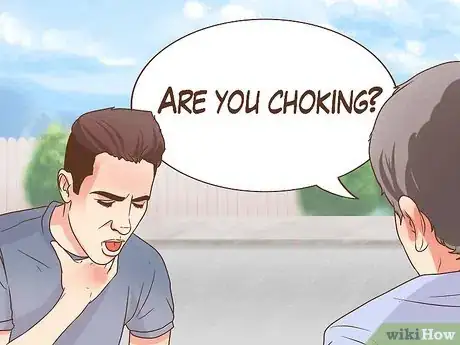
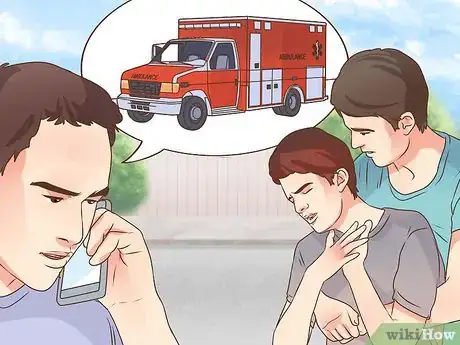
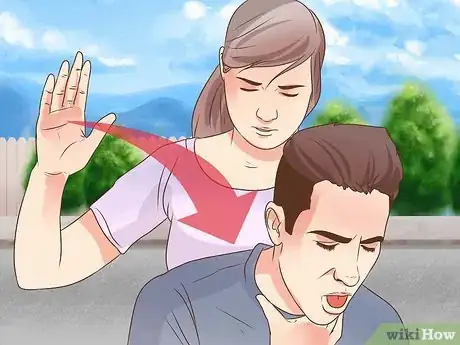
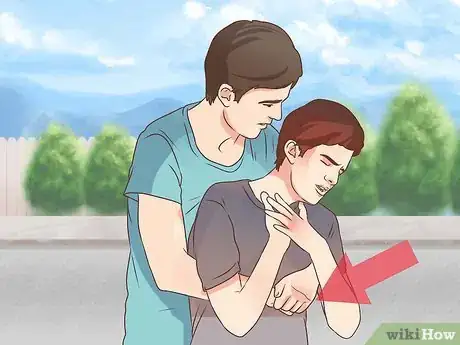
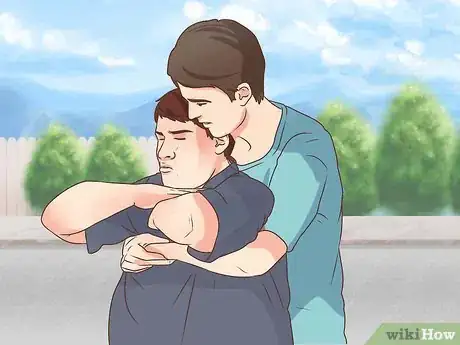
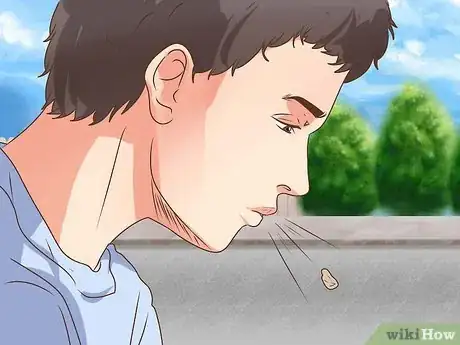
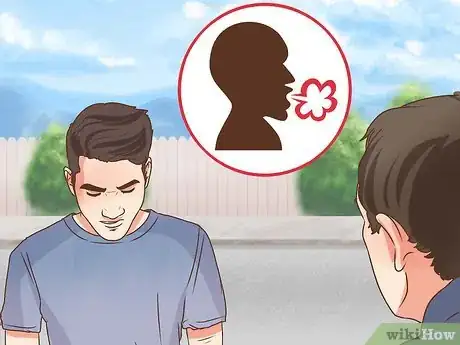
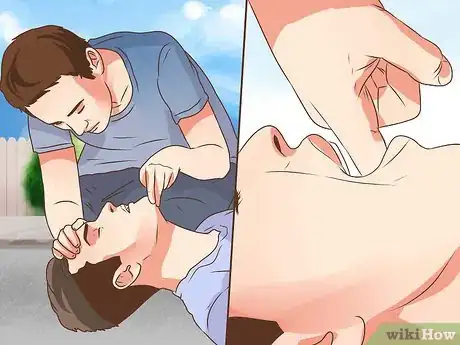
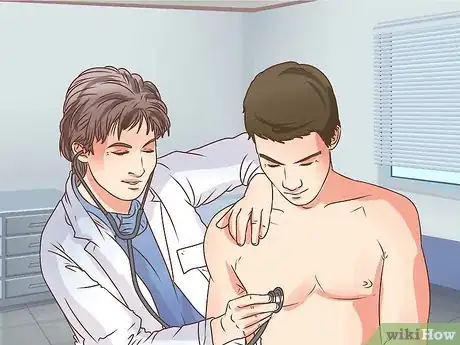
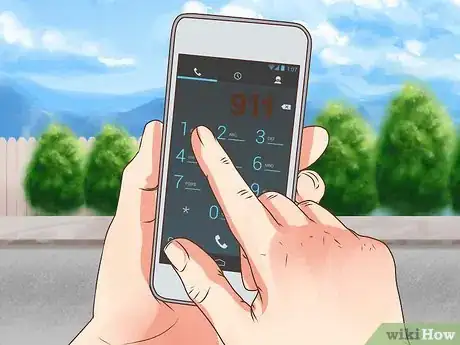

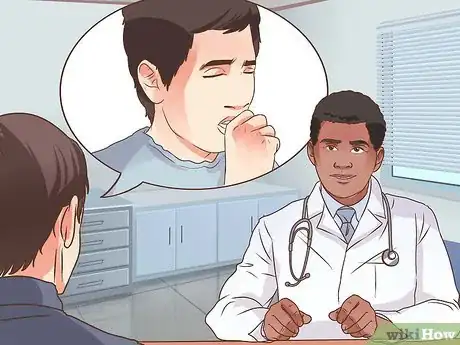

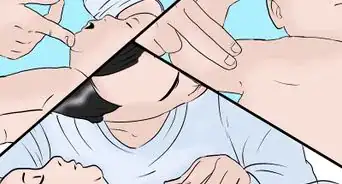

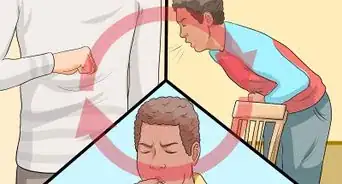
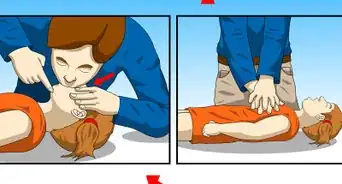
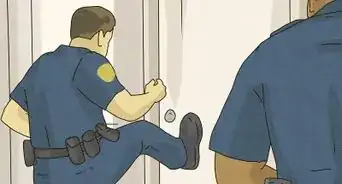

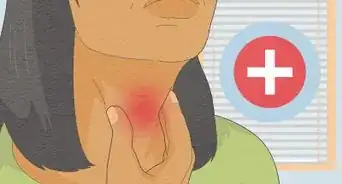

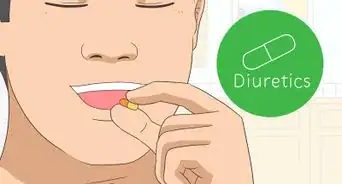













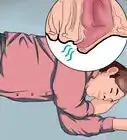
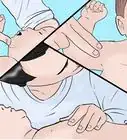

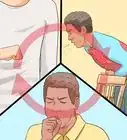



































Medical Disclaimer
The content of this article is not intended to be a substitute for professional medical advice, examination, diagnosis, or treatment. You should always contact your doctor or other qualified healthcare professional before starting, changing, or stopping any kind of health treatment.
Read More...